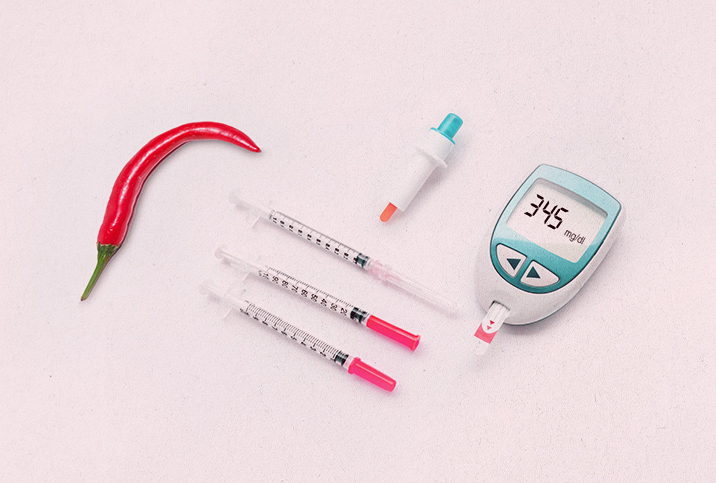Living With Peyronie's Disease and Its Sexual Side Effects

Peyronie's disease is a condition of the penis that most frequently affects men in their 40s or older. It's a relatively common condition, officially affecting about 10 percent of men, according to the National Institutes of Health (NIH).
However, it's believed to be under-reported and may affect as many as 20 percent of men.
The primary symptoms of Peyronie's involve a newly acquired curve, bend or other deformation in the shape of the erect penis. It's due to scarring on an internal structure in the shaft called the tunica albuginea, a tough membrane that sheathes the corpora cavernosa—two cylinders of spongy erectile tissue—inside the penis.
'We think about protection in terms of STI prevention, but it's also really important to protect the penis.'
When the tunica undergoes trauma, whether it's one major incident or ongoing micro-traumas, it can be damaged, which causes scar tissue to form on one side. This scar tissue may pull the penis in that direction when it's hard, as if the penis were a balloon that had a piece of tape stuck to one side before it was inflated.
Knowing this, how can you prevent Peyronie's? What's it like living with the condition? What are the sexual health implications and the outlook for men with Peyronie's disease?
Can you prevent Peyronie's disease?
We have a great deal of control over our bodies and health—think diet and exercise—but some conditions are less controllable than others. Peyronie's is one of those.
The fact that the condition more frequently affects older men lines up with the hypothesis that, as men age, structures such as the tunica albuginea wear down with use and become more susceptible to trauma.
It's also believed this kind of trauma occurs more frequently when the penis isn't fully erect. It's a lot easier to bend a penis and injure it when it's only partially hard. Couple that with the increased likelihood that older men may be more likely to have erectile dysfunction (ED), and it becomes clear that perhaps the best way to prevent Peyronie's disease is to take care of your erections.
Even if you're young and don't have issues with ED, though, one misplaced thrust can really ruin your day.
"A big message men need to know, especially when they're young, is protection," said Amy Pearlman, M.D., a men's health specialist and co-founder of Prime Institute in Fort Lauderdale, Florida. "We think about protection in terms of STI prevention, but it's also really important to protect the penis. Men can't do whatever they want with it. Partners need to know this, too. With certain positions, partners can injure the penis."
Here are some steps you can take to help reduce the chances of penis injury during sex:
- Take care when your partner is on top. When men report a single traumatic event that "broke" their penis, it's most likely to be a missed thrust with the partner on top.
- Take ED meds. Don't be too proud to take ED meds, especially if your erections are starting to lose a step.
- Use lube. Reducing friction can help prevent trauma.
- Guide it in. Don't count on blind thrusting to reinsert your penis if it slips out. You or your partner should give it a hand to avoid problems.
Living with Peyronie's disease
It's likely at least 10 percent of men have Peyronie's, and possibly as many as 20 percent, so living with it is certainly doable. During the waiting period of the acute phase—the six- to 12-month window when the scar hasn't yet stabilized and erections may hurt—it's important to get erections and keep the blood flowing, even if it may be a bit painful.
"Stretching" the penis via regular erections can help to minimize the eventual permanent effects of Peyronie's, and even reduce the curve.
"The body was made to move," Pearlman said. "So sometimes, not doing anything with that body part for nine months can make it worse."
Once it's progressed past the acute phase into the chronic, or stable, phase, you should consult with a urologist as to what, if any, treatments you might want to consider. If you're among a majority of men who have a curve of less than 30 degrees and you still have reliable erections, you'll likely want to just get to know your downstairs friend's new look and learn to live with it.
It's true the curvature of Peyronie's frequently causes an apparent reduction in length. That can prove troubling for some men, but any shortening is likely to be minute—maybe 0.5 cm to 1.5 cm, according to Cleveland Clinic.
If you were to undergo certain types of surgery to straighten your penis, the "shrinkage" effect could be significantly more pronounced.
"A plication procedure, where you put sutures in, is a shortening procedure," Pearlman said. "So the scar is where the penis is going to curve, and we're putting sutures in to shorten the longer side. It's a pretty simple procedure to do; people typically go home the same day. But when the person looks down, they're going to see a shorter penis. No one's happy about it, but some guys are OK with it."
What are the sexual health implications of Peyronie's disease?
For most men, the most troubling sexual health issues with Peyronie's disease are likely to occur during the acute phase while the scar is still forming. There is often some pain with erections and ejaculation.
The newly forming configuration of a man's penis can cause other kinds of trauma, too, which manifest in the bedroom. It's reasonable to be traumatized emotionally or mentally by injury your penis, watching as it changes from its regular shape and seeing it get shorter. Even knowing how common the condition is, men could benefit by speaking with a urologist who can put it in perspective. Seeking help from a sex therapist may help a number of guys, too.
The bend of the penis itself can cause issues with penetration. Most guys who have a curve of 30 degrees or less—below which surgical interventions aren't typically recommended—usually aren't going to have problems with penetration, such as discomfort for them or their partner.
Guys with a higher degree of curvature may receive a recommendation to undergo an intervention of some kind. Surgery to straighten the penis for men who get reliable erections or inserting an implant for ones who don't can often clear up those issues.
Peyronie's can contribute to ED even with a lower degree of curvature. Peyronie's-induced ED can be multifactorial. It could be partly caused by damage to the tunica or other structures in the penis, and it could be partly due to psychological stress and anxiety about the penis being different. For both of these, ED medication, wearable devices, counseling and communication with your partner can help.
Outlook for men with Peyronie's disease
Peyronie's goes away sometimes, but a majority of cases don't.
However, the outlook for men with Peyronie's is positive. There are many options for low-risk interventions for more pronounced curves. For guys who have 30 degrees or less of curvature and opt to live with it, the aforementioned counseling, communication, and ED meds and devices, if needed, can go a long way toward helping them adapt.
Once the acute phase has ended, the pain and discomfort typically dissipate if the curve is less than 30 degrees. In the long term, as long as you take care of the way you use your erection, it normally won't get any worse once it's stabilized.
Living with Peyronie's is something millions of guys around the world manage to do every day while still enjoying a healthy, happy sex life.


















